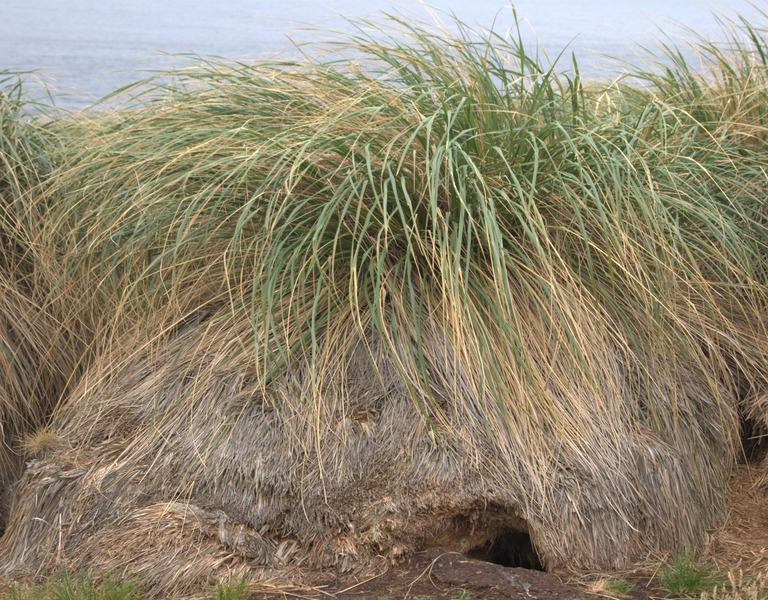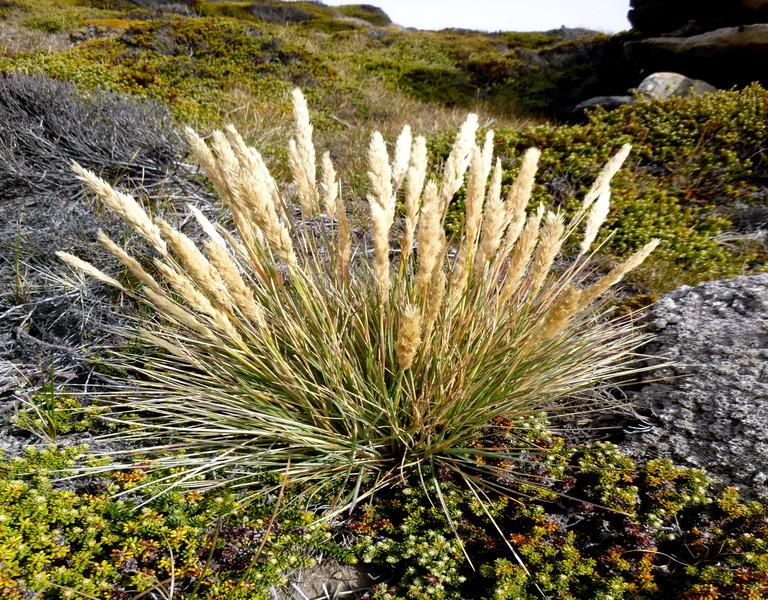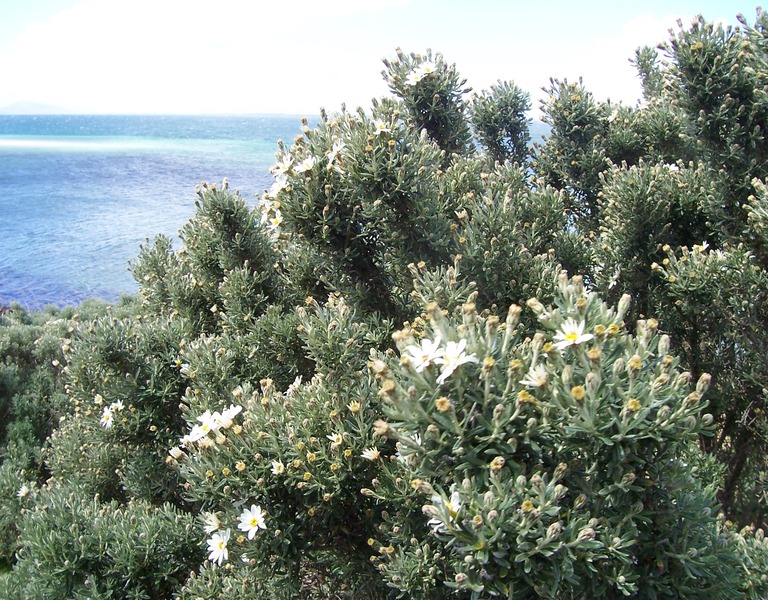HABITATS
NATIVE HABITAT DESCRIPTIONS:
Tussac grass
Tussac grass forms one of the most incredible habitats of the Falkland Islands abundant in biomass, carbon and wildlife. Extensive wind-rustled stands of tussac can cover whole islands, stretch nearly a kilometre inland and even grow on some of the highest hills. The pedestals of dead vegetation capped with living tufts of grass can reach over 2.5 metres high and provide a bed for sleeping sea lions. In the densest tussac, those most like the original habitats, the grass blades become fixed together by friction making navigation through tussac incredibly difficult. If you took two books and ‘riffle-shuffle’ them as you might a pack of cards, so that the pages of each book are alternately interwoven, then try to pull them apart you’ll understand how strong a force friction can be.
In dense tussac grass it is easy to become lost, to walk in circles or triple a journey in both time and distance as you navigate pedestals and entangled grass blades that are reluctant to divide. A short walk can feel like 10 kilometres as you climb up, over and around the pedestals. This is some of the hardest exercise to be had in the Falklands…an old-growth green gym to be tackled by the bravest and most stubborn. At the end of a walk through dense tussac your legs will burn, and morale may need replenishment.
Where light penetrates through the dense mass of grass baby tussac plants push through the soil. These are the pedestals of the future that will fill gaps in the old-growth tussac, where each plant can be 200 years or more and the habitat can be thousands of years old. On the edges of the tussac other species like wild celery, sword grass and even bluegrass add diversity to the biomass.
If you huddle down among the intertwined grass the habitat buffers the mightiest gales to near stillness. If you put your hand into the soil surface it will be 70 to 85% moisture, the soil surface will be smothered by dead vegetation adding another buffer against drying and providing the next generation of soil which can form at rates fifteen times faster than the usual peat formation of one millimeter a year. Tussac habitats sequester more carbon than any other terrestrial habitat. Beauchene Island, in the South-East of the Falklands, is first on the global list, Kidney Island in the North is second. Further peat cores may give the Falkland Islands the top ten in the global list. Tussac peat is the deepest of the Falkland Island soils, with depths of up to 13m. The above ground carbon, locked in the living plant and the mass of dead vegetation of the pedestals and leaf litter, also holds vast amounts of carbon.
The properties of tussac soil give it a structure that burrowing seabirds love. The tunnels they create are supported by the structurally stable soil, layered like cakes and bound together by a string of old roots, meaning the burrows are unlikely to collapse or fill in. The high pedestals of tussac grass create the perfect micro-climate to reduce wind-drying offering the birds a refuge from the harsh realities of the South Atlantic climate. Every summer an influx of seabirds, amounting to millions across the Falkland Islands, come to tussac habitats to nest, bringing with them a massive season-long injection of marine nutrients each year. These semi-digested nutrients give life to the tussac and keep it enriched providing a habitat scale symbiosis which is an incredible sight at places like Kidney Island where tens of thousands of sooty shearwater return at the end a day’s feeding at sea. As dusk begins the air is enriched with shearwaters circling in the reddening skies of the sunset. The effect is an emotional reset for anyone with a love of wildlife and untamed places.
It’s not just sooty shearwaters tussac grass supports. There are albatross, Magellanic penguins, diving petrels, white-chinned petrels, storm petrels, great shearwater and prions that rear their next generations burrowed into tussac habitats. At the end of a day, while Magellanic penguins bray like donkeys giving them their more colloquial name; the jackass penguin, there can be a throng of seabirds returning to their nests. Out of a total of 62 birds breeding in the Falkland Islands 46 use tussac either for nesting or feeding. Some of the largest and smallest Falkland species thrive in tussac including the Falklands smallest bird species, the endemic Cobb’s wren, which thrives in rodent-free tussac habitats.
It’s not all birds, large marine mammals like southern sea lions, Falkland Island fur seals and southern elephant seals rest and even breed in the tussac. These marine giants and the more diminutive species live side-by-side. Tussac habitats are the place to find species new to science, such as micro-moths and spiders that hide in the pedestals or appear as dusk sets in. There are camel crickets and beetles and detritus feeders that help break down the dead vegetation, but the process of decay is slow. The high moisture content of the soil resists breakdown, meaning accumulation of dead plant matter massively outstrips its decay. Tussac grass habitats are one of the most fascinating peatland habitats on earth.

Bluegrass
In 1847 the Victorian botanist, Sir Joseph Hooker wrote that bluegrass was the ‘most abundant’ grass species in the Falkland Islands. He noted that it occurred on sandy shores and in rocky places both near the sea and up on the hills. Sixty-six years later Skottsberg (1913) said, ‘I have met with it only once…among rocks near the shore.’ This grass species has been a victim of its own palatability to introduced livestock that have grazed it down to a near threatened habitat type.
Once the most abundant grass species in the Falklands its range is now severely restricted and you have to travel to the high hills or offshore islands to find a mirror to the past. On islands like Motley, Flat Jason, Split and North bluegrass still thrives on peat soils forming little tussocks and stumbling hollows which are rich in ferns and flowers. Bluegrass leaves can be blue-tinged or purple, large stands of it can give a pink hue to the landscape. Confusingly Fuegian couch often appears to be ‘bluer’ than bluegrass making identification difficult to an untrained eye.
Bluegrass is both a vulnerable and robust species, a paradox habitat that prefers high soil moisture levels, especially in peatland habitats, but is able to grow in soils with water content lower than 10%, in coastal patches. While it has been severely reduced it can reappear relatively quickly in rested paddocks offering a positive sign for the potential of this habitat type.
Old established bluegrass habitats buffer the soil from the ever-present drying winds of the Falkland Islands meaning soils can remain moist and hold rich stores of carbon but in drier stands soil carbon can be as low as 15%. The very best peatland bluegrass habitats develop a soil high in both moisture and carbon. It can be a rich environment offering a home for a variety of Falkland Island native plant species including Fuegian couch, Cinnamon grass, Meyen’s bent, Small fern. Almond flower, Antarctic bedstraw, Antarctic buttercup, Falkland lavender, Native wood rush, Falkland’s smooth ragwort, Mountain berry, Scurvy grass and Rock cress. This rich habitat attracts black-chinned siskins, Snipe, Grass wren, Tussac bird, Striated caracara, White-bridled finch, Austral thrush and Dark faced ground tyrant. On Motley Island the edge of the bluegrass habitat has nesting Black-crowned night herons and Magellanic penguins.
The highest quality bluegrass habitats can have a sward height over one metre high that form into ankle-turning tussocks between which the gaps are filled with small fern, Antarctic bedstraw and Scurvy grass. The soils are high in organic matter, uncompacted and often well over a metre deep with a high water table. The deeper the soil the greater the carbon holding capacity. Studies have found that a 60% increase in soil depth can result in a similar increase in soil carbon levels. Though the very deepest soils will have a higher carbon content towards the base.

Boxwood
Boxwood is the closest to a native tree species in the Falkland Islands. Where it thrives the habitat can stretch to three metres of closed canopy which are a mass of intertwined tangles of branches. The woody trunks are twisted and bent like an enchanted forest in miniature. The leaves are opposite with successive pairs perpendicular to the last. This creates a spin illusion of greenery as if the branches have twisted around on themselves. Beneath the boxwood, at places like Hummock Island and Split Island, weevils, grubs, beetles, camel crickets and spiders thrive bringing in small birds like Long-tailed meadowlarks, Tussock birds and White-bridled finches that weasel bugs from the leaf litter and soil.
These gnarly dwarf forests resist human encroachment. The branches develop into an unforgiving mangle that only those tasked with surveying the habitat are stubborn enough to push through. Other people tend to sit on the edge and enjoy the aroma of summer flowers and the flitting of small birds that move from top to top in search of succulent invertebrates. In late summer the boxwood blossom can fill the air with rich perfume attracting hoverflies and other insects. The Boxwood habitats on Split Island are one of the few native habitats still holding the green spider (Molinaranea magellanica). Here they feed on the insects and evening micro-moths attracted by the scent-rich flowers.
Where Boxwood thrives the soils are covered in a dark blanket of shade meaning an understory can be absent beneath closed canopy stands. Soil moisture and carbon is average for a Falklands peat habitat. Perhaps due to the lack of an understory, or because boxwood is re-establishing on previously damaged soil. Still, it’s home to Magellanic penguins, finches and hunting hawks. On the cliffs of Dunbar albatross nest among stunted boxwood plants that have clung on in refuges geographically isolated from the munching mouths of sheep and cows.
Where grazing pressure has been released boxwood readily expands its range. Tea Island, Dunbar, Hummock Island and Turkey Island are all seeing boxwood expansion suggesting it will readily move onto damaged soils. This trait of expansion gives natural regeneration potential that may see small boxwood forests re-establish on West Falkland, as well as islands off the west coast. Planting trials have shown that Boxwood will grow on bare peat and even on clay patches making it a robust species, hardy and able to take advantage of even a meagre niche.
For a miniature half-tree boxwood is exceptionally robust. It can thrive on nutrient reduced soils, expand its range as soon as grazing pressure is released. It can form closed canopy habitats that steal all but a hint of light from the land surface. Its roots and branches cling together to exclude all but the most foolish people, or those whose job demands they enter the enchanted skin-scuffing world of Boxwood.

Fachine whitegrass habitats
Like Boxwood habitats Fachine can become a tangle of branches but it’s a more forgiving plant and will leave your skin intact if you have to walk through it. These Asteraceae are like woody daisies reaching a maximum height of 2 metres but rarely creating a closed canopy like boxwood. When in flower the shrub is a crown of white attracting hoverflies and moths that feed on the nectar and taking the place of bees as the primary pollinators. Fachine habitats are a matrix of shrub and acid grassland, rich in plant and bird species. If you sit still in fachine rich habitat inquisitee grass wrens will jink through the shrubs till they come within an arm’s length of you. The air can be rich with their singing as they flit from the tops of Fachine shrubs to mark their territory boundaries through song.
The best Fachine habitats are at Patricia Luxton NNR, Purvis and Coast Ridge on West Falkland. The Fachine on the western edge of Long Mountain holds some of the most botanically rich habitat in the Falkland Islands. Here the Fachine habitat holds 25 native species including orchids, almond flower, tall fern, small fern, pale maiden, berry lobelia and scurvy grass. The flowers of orchids, pale maidens, and scurvy grass, as well as the tiny flowers of almond flower and the rich blossom of Fachine, add a wonder to the landscape. Grass wrens are rampant here too and like at Patricia Luxton NNR, Coast Ridge and Purvis they will come to within an arm’s length if you sit quietly. There are other birds including white-bridled finch and variable hawks giving a depth to the habitat that’s hard to find in regenerating Fachine.
The soil of a Fachine habitat can be high in moisture and over 40 cm deep. Grasses, flowering plants and leaf litter buffer the soil against wind-drying but Fachine can also grow on peat soils that have become smothered in dense wind-blown clay. Fachine can reach above invasive species like Marram grass and add a higher native component to sites comprised mostly of non-native species.
The largest area of fachine habitat is the 2,300acre Patricia Luxton NNR. This reserve is filled with metre high Fachine shrubs, set in a matrix of whitegrass and flowering plants. At one time the Falklands habitat that was 800metres or more from the coast was probably composed of these Fachine habitats. Before people arrived they would have been set in a matrix of bluegrass rather than whitegrass. Even now at Patricia Luxton NNR and Purvis the Fachine stretches down to the coast. Whether this is its natural range or a response to the severe reduction of Tussac grass, that would typically outcompete Fachine on the coastal fringe, is hard to say. Before people arrived the soils would have been wetter, the vegetation taller, the flowers more rich. Pale maidens would have had to stretch their stalks higher to reach above the sward, grass wrens would have sang from the white flowered Fachine shrubs, their tiny woven nests set in the dense mass of twigs of the shrubs of the shrubs central structure. The habitat would have been more prevalent and more ‘alive’ similar to how Long Mountain and Patricia Luxton are now.
Fachine has been removed from large parts of the Falkland’s by centuries of burning and grazing, but a large seedbank means it readily thrives when these pressures are removed. A careful search through ungrazed Whitegrass camps can reveal an army of Fachine slowly growing under the light-reducing grasslands. Once it escapes and reaches above the competition it thrives and takes hold. Areas of Fox Bay are rapidly turning into Fachine and acid grassland habitats. A drive towards Springpoint from Fox Bay reveals re-establishing Fachine habitats jutting out from the Whitegrass and as the habitat begins to thrive again the grass wrens return adding song to the land.




